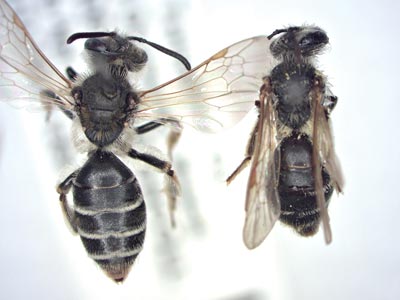 |
| Large and small ground-nesting bees, Andrena nasonii, from the study region. Photo by Heather Grab |
By Sue Smith-Heavenrich
A recent study shows that common ground-nesting bees grow smaller in heavily farmed landscapes than in natural areas. In a Northeast SARE (Sustainable Agriculture Research and Education)-funded study, Heather Connelly and her colleagues at Cornell University collected more than 100 Adrena nasonii females during strawberry bloom in May 2014 and 2015. They measured the head and the distance between the wings and found that bees living in intensively farmed areas were significantly smaller than bees living in natural landscapes.
Connelly then randomly sampled the largest bees from natural habitats and smallest bees from agricultural habitats and figured out how much pollen the female bees were carrying on their legs.
“Small bees carried a 40-percent smaller pollen load than large bees did,” she said. That’s critical for the bees, because they use the pollen they collect to provision their nests. Carrying less pollen could translate into less food for larvae, which, in turn, may mean development of smaller adults in the next generation.
Connelly also noted that larger females tend to fly farther than smaller females, and that could affect pollination of the strawberries, apples, blueberries and cherries that depend on pollination services delivered by these early pollinators.
One explanation for the observed reduction in size could be increased exposure to pesticide residues in the intensive agricultural landscapes. This would include organic pesticides, such as copper sulfate and kaolin clay. The clay, Connelly said, irritates the bees, so farmers should avoid spraying it when bees are foraging.
Another explanation could be reduced resource quality due to a simplified agricultural landscape. Experimental evidence indicates that growing strips of wildflowers with crops increases pollinator visits.
“Researchers report more bees and a greater diversity of bees in plots with wildflower strips,” Connelly explained. But will adding wildflower strips solve the problem of small bees? That’s what Connelly and her colleagues are currently investigating. Preliminary results indicate that when wildflower strips are added to the agricultural plots, bees don’t get smaller. The question for farmers will be whether the cost of taking land out of crop production is worth the benefit of providing a resource-rich environment for the bees.
